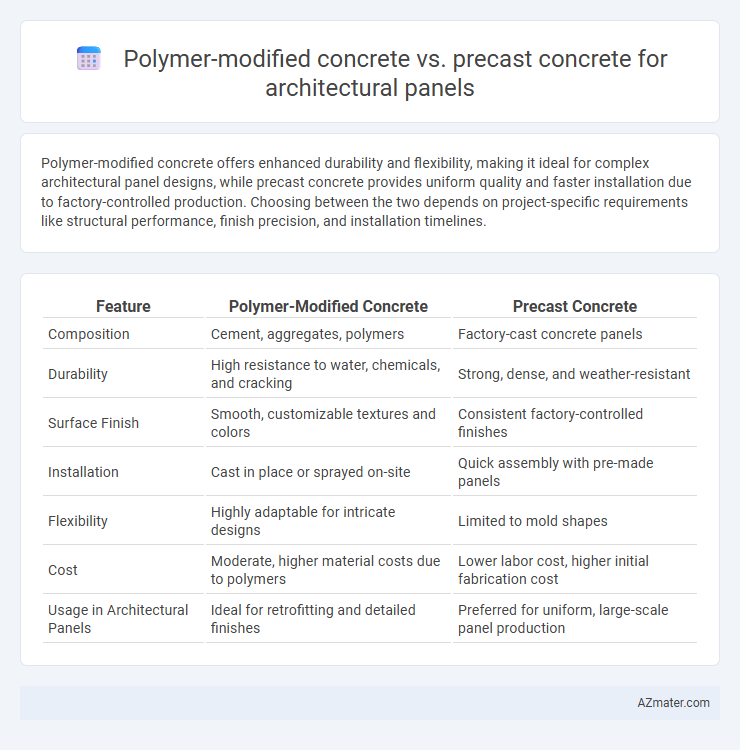Polymer-modified concrete offers enhanced durability and flexibility, making it ideal for complex architectural panel designs, while precast concrete provides uniform quality and faster installation due to factory-controlled production. Choosing between the two depends on project-specific requirements like structural performance, finish precision, and installation timelines.
Table of Comparison
| Feature | Polymer-Modified Concrete | Precast Concrete |
|---|---|---|
| Composition | Cement, aggregates, polymers | Factory-cast concrete panels |
| Durability | High resistance to water, chemicals, and cracking | Strong, dense, and weather-resistant |
| Surface Finish | Smooth, customizable textures and colors | Consistent factory-controlled finishes |
| Installation | Cast in place or sprayed on-site | Quick assembly with pre-made panels |
| Flexibility | Highly adaptable for intricate designs | Limited to mold shapes |
| Cost | Moderate, higher material costs due to polymers | Lower labor cost, higher initial fabrication cost |
| Usage in Architectural Panels | Ideal for retrofitting and detailed finishes | Preferred for uniform, large-scale panel production |
Introduction to Polymer-Modified Concrete and Precast Concrete
Polymer-modified concrete incorporates polymers to enhance adhesion, flexibility, and durability, making it ideal for architectural panels requiring high performance and aesthetic precision. Precast concrete involves casting concrete in controlled environments before transportation, offering consistent quality, faster installation, and reduced on-site labor for architectural applications. The selection between polymer-modified and precast concrete depends on project-specific needs such as design complexity, environmental conditions, and structural requirements.
Composition and Material Properties
Polymer-modified concrete incorporates polymers such as styrene-butadiene or acrylics into the cement matrix, enhancing adhesion, flexibility, and resistance to chemicals and weathering, making it ideal for architectural panels requiring durability and aesthetic precision. In contrast, precast concrete is produced in controlled factory environments using traditional cement, aggregates, and admixtures, offering high compressive strength, uniformity, and dimensional accuracy suitable for large-scale architectural panel production. The polymer modification significantly improves tensile strength and reduces permeability compared to standard precast concrete, resulting in panels with superior surface finish and longevity in harsh environmental conditions.
Manufacturing Processes
Polymer-modified concrete for architectural panels involves integrating polymers into the mix to enhance adhesion, flexibility, and durability during casting and curing, enabling intricate surface textures and custom finishes. Precast concrete manufacturing relies on controlled factory conditions for mixing, casting, and curing large panels in reusable molds, ensuring uniformity, dimensional accuracy, and accelerated production cycles. The polymer modification process requires precise dosage and mixing techniques, while precast concrete benefits from standardized mold systems and automated curing environments to meet architectural specifications.
Structural Performance Comparison
Polymer-modified concrete enhances tensile strength, durability, and crack resistance compared to traditional precast concrete, making it ideal for architectural panels subjected to dynamic loads and environmental stress. Precast concrete offers uniform quality and faster installation but typically exhibits lower flexural strength and higher brittleness than polymer-modified variants. Studies indicate polymer modification improves adhesion and impact resistance, leading to superior long-term structural performance in facade applications.
Durability and Weather Resistance
Polymer-modified concrete enhances architectural panels by significantly improving durability and resistance to weathering through increased tensile strength and reduced permeability. Precast concrete offers consistent quality and uniform curing conditions, which contribute to long-term durability but can be more susceptible to micro-cracking under extreme weather variations. The incorporation of polymers in concrete formulations provides superior resistance to freeze-thaw cycles, chemical attack, and moisture ingress compared to standard precast panels.
Architectural Design Flexibility
Polymer-modified concrete enhances architectural design flexibility by allowing for intricate shapes, finer details, and varied textures due to its improved workability and adhesion properties. Precast concrete offers consistent quality and dimensional accuracy but is generally limited to standardized molds, reducing customization options in architectural panels. The use of polymer-modified concrete supports innovative, complex design elements that precast concrete panels cannot easily replicate.
Installation Techniques and Speed
Polymer-modified concrete offers faster installation for architectural panels due to its enhanced bonding properties and reduced curing time, allowing quicker handling and placement on-site. Precast concrete panels are manufactured off-site, enabling precise quality control and rapid on-site assembly, significantly cutting down installation time compared to traditional cast-in-place methods. Both methods streamline the construction process; polymer-modified concrete excels in in-situ applications while precast concrete panels ensure uniformity and speed through modular installation.
Sustainability and Environmental Impact
Polymer-modified concrete enhances the durability and longevity of architectural panels, reducing maintenance and material waste over time, which contributes to lower environmental impact compared to traditional concrete. Precast concrete panels enable efficient manufacturing with precise resource control and minimized onsite waste, promoting sustainable construction through reduced carbon emissions and energy consumption during installation. Both materials offer distinct sustainability benefits, with polymer modifications improving lifecycle performance and precast methods optimizing resource use and reducing construction phase environmental disturbances.
Cost Analysis and Economic Considerations
Polymer-modified concrete (PMC) incurs higher initial material costs due to the inclusion of polymers that enhance durability and flexibility, potentially reducing long-term maintenance expenses compared to traditional precast concrete panels. Precast concrete offers economies of scale through standardized factory production, lowering labor costs and accelerating installation times, which can result in overall cost savings for large-scale architectural projects. Economic considerations must weigh the upfront investment of PMC against its lifespan advantages and the reduced risk of cracking, while precast concrete's cost-effectiveness depends on project size and complexity.
Choosing the Best Solution for Architectural Panels
Polymer-modified concrete enhances durability and adhesion, making it ideal for architectural panels requiring intricate designs and resistance to weathering. Precast concrete offers consistent quality, faster installation, and reduced on-site labor, suitable for large-scale projects demanding uniformity and structural reliability. Selecting the best solution depends on project-specific factors such as design complexity, environmental exposure, and installation timeline.

Infographic: Polymer-modified concrete vs Precast concrete for Architectural panel
 azmater.com
azmater.com